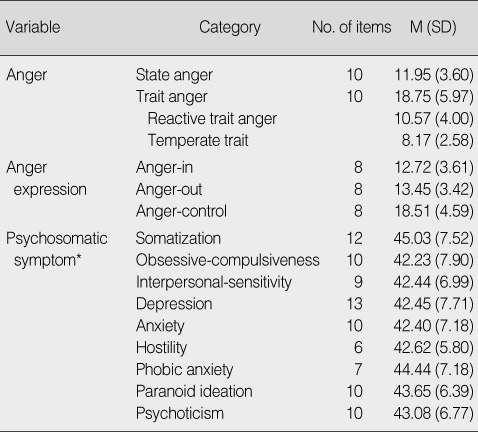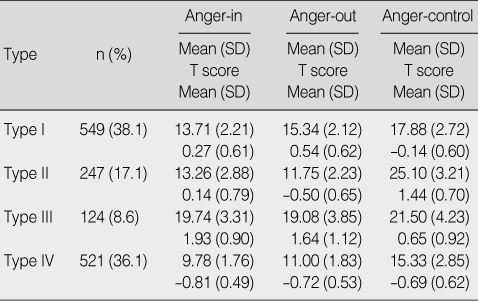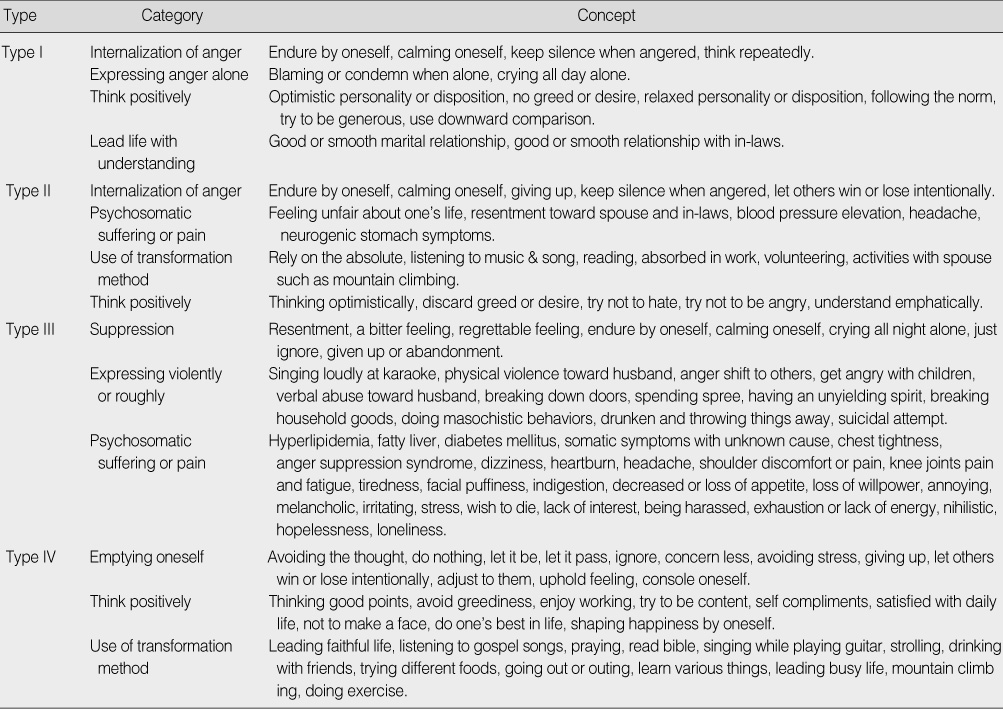Articles
- Page Path
- HOME > J Korean Acad Nurs > Volume 39(4); 2009 > Article
-
Original Article
- Anger Expression Type and Mental Health in Middle Aged Women
- Il-Rim Choi
-
Journal of Korean Academy of Nursing 2009;39(4):602-612.
DOI: https://doi.org/10.4040/jkan.2009.39.4.602
Published online: August 31, 2009
Professor, College of Nursing, Chonbuk National University, Jeonju, Korea.
- Address reprint requests to: Choi, Il-Rim. College of Nursing, Chonbuk National University, San 2-20 Geumam-dong, Deokjin-gu, Jeonju 561-180, Korea. Tel: 82-63-270-3108, Fax: 82-63-270-3127, choi-ir@chonbuk.ac.kr
Copyright © 2009 Korean Society of Nursing Science
Abstract
-
Purpose
- The purpose of this study was to identify type of anger expression and mental health in middle aged women.
-
Methods
- From August to October 2005, survey data were collected by using the State Trait Anger Expression Inventory and Symptom Check List-90-Revision (SCL). Participants (1,442) were classified into four types of anger expression by K-mean cluster analysis. For collecting interview data for content analysis, 18 participants (4-5 participants from each type of anger expression) were recruited. The interview data were collected between March and September 2006.
-
Results
- The average score of the state anger of middle-aged women was 11.95, and that of the trait anger was 18.75. The average anger expression scores were 12.72 for Anger-In, 13.45 for Anger-Out, and 18.51 for Anger-Control. The average SCL scores were 45.03 for somatization, 42.23 for obsessive-compulsiveness, 42.44 for interpersonal sensitivity, 42.45 for depression, 42.40 for anxiety, 42.62 for hostility, 44.44 for phobic anxiety, 43.65 for paranoid ideation, and 43.08 for psychoticism. The anger expression types identified in this study were 1) anger-out in secret, 2) anger-control with a patience, 3) anger-out with suppression, and 4) low anger expression type. The psychosomatic symptom scores were the highest in type III (anger-out with suppression), and the lowest in type IV (low anger expression type).
-
Conclusion
- This study can be helpful in assisting middle aged women to control their anger effectively and may contribute to the improvement of their mental health.
- 1. Bruehl S, Burns JW, Chung OY, Ward P, Johnson B. Anger and pain sensitivity in chronic low back pain patients and pain-free controls: The role of endogenous opioids. Pain. 2002;99:223–233.ArticlePubMed
- 2. Bruehl S, Chung OY, Burns JW. Differential effects of expressive anger regulation on chronic pain intensity in CRPS and non-CRPS limb pain patients. Pain. 2003;104:647–654.ArticlePubMed
- 3. Burns JW, Bruehl S, Caceres C. Anger management style, blood pressure reactivity, and acute pain sensitivity: Evidence for "Trait×Situation" models. Annals of Behavioral Medicine. 2004;27:195–204.ArticlePubMed
- 4. Chon KK, Kim DY, Yi JS. Development of the STAXI-K: IV. Korean Journal of Art Therapy. 2000;7:33–50.
- 5. Derogatis LR. SCL-90: Administration, scoring, and procedures manual-1 for the revised version. 1977;Baltimore, MD, Clinical Psychometrics Research.
- 6. Population Census. Jeonju city data. 2004;Retrieved April 27, 2004. http://www.jeonju.go.kr.
- 7. Kerby DS, Brand MW, John R. Anger types and the use of cigarettes and smokeless tobacco among native American adolescents. Preventive Medicine. 2003;37:485–491.ArticlePubMed
- 8. Kim KI, Won HT, Lee JH, Kim KY. Standardization study of symptom check list-90 in Korea: Characteristics of normal responses. Journal of the Korean Neuropsychiatric Association. 1978;17:449–458.
- 9. Population Census. Korea National Statistical Office data. 2002;Retrieved April 27, 2004. from http://www.nso.go.kr.
- 10. Larson RJ, Kasimatis M. Day-to-day physical symptoms: Individual differences in the occurrence, duration, and emotion concomitants of minor daily illness. Journal of Personality. 1991;59:387–423.ArticlePubMed
- 11. Lee PS. Correlational study among anger, perceived stress and mental health status in middle aged women. Journal of Korean Academy of Nursing. 2003;33:856–864.ArticlePubMedPDF
- 12. Lee PS, Sohn JN, Lee YM, Kang HC. Prediction model on mental health status in middle-aged women of an urban area. Journal of Korean Academy of Nursing. 2005;35:239–251.ArticlePubMedPDF
- 13. Lee YM. The Lived experiences of the middle-aged women's anger. 2003;Seoul, Korea University. Unpublished doctoral dissertation.
- 14. Linden W, Hogan BE, Rutledge T, Chawla A, Lenz JW, Leung D. There is more to anger coping than "in" or "out". Emotion. 2003;3:12–29.ArticlePubMed
- 15. Nicholson RA, Gramling SE, Ong JC, Buenevar L. Differences in anger expression between individuals with and without headache after controling for depression and anxiety. Headache. 2003;43:651–663.ArticlePubMed
- 16. Ohira T, Iso H, Tanigawa T, Sankai T, Imano H, Kiyama M, et al. The relationship of anger expression with blood pressure levels and hypertension in rural and urban Japanese communities. Journal of Hypertension. 2002;20:21–27.ArticlePubMed
- 17. Park YJ, Baik SN, Choi YH, Shin HJ, Moon SH, Kim SY. The relation of trait anger and anger expression to cardiovascular responses and depression in middle-aged Korean women. Journal of Korean Academy of Nursing. 2005;35:1371–1378.ArticlePubMedPDF
- 18. Park YJ, Baik SN, Shin HJ, Yoon JW, Chon SH, Moon SH. Anger, cardiovascular health and depression in middle-aged Korean men: The mediating effect of social support. Journal of Korean Academy of Nursing. 2006;36:863–871.ArticlePubMedPDF
- 19. Park YJ, Han KS, Shin HJ, Kang HC, Chon SH, Moon SH, et al. Prediction on the negative outcomes of anger in female adolescents. Journal of Korean Academy of Nursing. 2004;34:172–181.ArticlePubMedPDF
- 20. Park YJ, Han KS, Shin HJ, Kang HC, Moon SH. Anger, problem behaviors, and health status in adolescentwomen. Journal of Korean Academy of Nursing. 2004;34:1234–1242.ArticlePubMedPDF
- 21. Park YJ, Park ES, Kim SJ, Yang SS, Shin HJ, Im HS, et al. Anger and health status in late school-age children. Journal of Korean Academy of Nursing. 2005;35:888–895.ArticlePubMedPDF
- 22. Rutledge T, Reis SE, Olson M, Owens J, Kelsey SF, Pepine C, et al. Psychosocial variables are associated with atherosclerosis risk factors among women with chest pain: The wise study. Psychosomatic Medicine. 2001;63:282–288.ArticlePubMed
- 23. Schum JL, Jorgensen RS, Verhaghen P, Sauro M, Thibodeau R. Trait anger, anger expression, and ambulatory blood pressure: A meta-analytic review. Journal of Behavioral Medicine. 2003;26:395–415.ArticlePubMedPDF
- 24. Siegel JM. Anger and cardiovascular risk in adolescents. Health Psychology. 1984;3:293–313.ArticlePubMed
- 25. Spielberger CD. Professional manual for the state-trait anger expression inventory (STAXI). 1988;Tampa, FL, Psychological Assessment Resources.
- 26. Spielberger CD. Manual for the state-trait anger expression scale. 1996;Port Huron, MI, Sigma Assessments System.
- 27. Starner TM, Peters TM. Anger expression and blood pressure in adolescents. Journal of School Nursing. 2004;20:335–342.ArticlePDF
- 28. Thomas SP, Atakan S. Trait anger, anger expression, stress, and health status of American and Turkish mid-life women. Health Care for Women International. 1993;14:129–143.ArticlePubMed
REFERENCES
Figure & Data
REFERENCES
Citations

- Anger, personality traits and psychopathological symptoms in subjects exposed to negative interpersonal actions in workplaces: an observational study in a large sample attending a Center for Occupational Stress
Barbara Forresi, G. Michelini, W. Sapuppo, G. Costa, G. Castellini, S. Livellara, R. Gregori Grgič
International Archives of Occupational and Environmental Health.2022; 95(8): 1763. CrossRef - High Anger Expression is Associated with Reduced Cortisol Awakening Response and Health Complaints in Healthy Young Adults
Ángel Romero-Martínez, Luis Moya-Albiol
The Spanish Journal of Psychology.2016;[Epub] CrossRef - The Relation of Parenting Stress, Anger and Somatization Symptom of Mothers
Eun-Kyung Kim, Chin Kang Koh
Korean Journal of Stress Research.2016; 24(3): 151. CrossRef - Anger Expression Types and Interpersonal Problems in Nurses
Aekyung Han, Jongsoon Won, Oksoo Kim, Sang E. Lee
Asian Nursing Research.2015; 9(2): 146. CrossRef - Patterns of Anger Expression among Middle-aged Korean Women: Q methodology
Yong Mi Lee, Geun Myun Kim
Journal of Korean Academy of Nursing.2012; 42(7): 1001. CrossRef - The Related Factors Influencing on Self-rated Health Level of Middle-aged Women
Hyejin Lee, Kyung-Hea Lee, Eunkyung Kim, Mi-Jung Kim, Suk-Man Hwang
Korean Journal of Community Nutrition.2012; 17(3): 290. CrossRef - The Relation Among Parenting Stress, Anger and Anger Expression in Infant's Mothers
Dong-Young Park
Journal of the Korea Academia-Industrial cooperation Society.2012; 13(3): 1170. CrossRef - A Comparison of the Health Status and Health Promoting Behaviors between Type D Personality and Non-Type D Personality in Middle aged Women
Sun Hyoung Bae, Jin-Hee Park, Euigeum Oh
Korean Journal of Women Health Nursing.2011; 17(4): 337. CrossRef
Anger, Anger Expression and Mental Health in Middle Aged Women (N=1,442)
*Transformation to T-score.
Anger Expression Type by Anger Expression Score (N=1,441)
Type I=anger-out in secret type; Type II=anger-control with patience type; Type III=anger out with suppression type; Type IV=low anger expression type.
The Characteristics of Anger Expression Type I, Type II, Type III, and Type IV
Type I=anger-out in secret type; Type II=anger-control with patience type; Type III=anger out with suppression type; Type IV=low anger expression type.
The Mental Health by Anger Expression Type
a, b, c, d: Result of Duncan's multiple comparison test (Different alphabet means significant difference among the groups).
Type I=anger-out in secret type; Type II=anger-control with patience type; Type III=anger out with suppression type; Type IV=low anger expression type.
*Transformation to T-score.
Type I=anger-out in secret type; Type II=anger-control with patience type; Type III=anger out with suppression type; Type IV=low anger expression type.
Type I=anger-out in secret type; Type II=anger-control with patience type; Type III=anger out with suppression type; Type IV=low anger expression type.
a, b, c, d: Result of Duncan's multiple comparison test (Different alphabet means significant difference among the groups). Type I=anger-out in secret type; Type II=anger-control with patience type; Type III=anger out with suppression type; Type IV=low anger expression type.
 KSNS
KSNS
 E-SUBMISSION
E-SUBMISSION




 Cite
Cite

